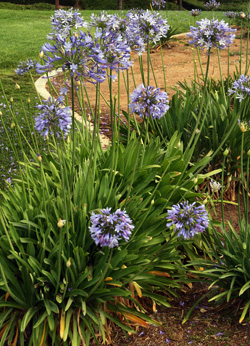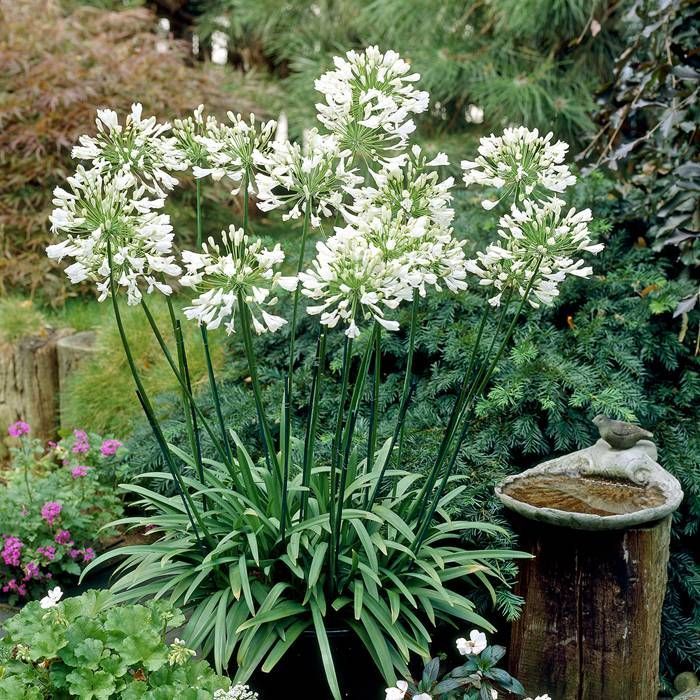Agapanthus Varieties: Choosing the very best for Your Landscape
Agapanthus Varieties: Choosing the very best for Your Landscape
Blog Article
Mastering the Art of Agapanthus Treatment: Essential Actions for Healthy Development and Vibrant Flowers
In the world of cultivation, the cultivation of agapanthus stands as a satisfying venture for those that seek to support these elegant blooming plants. From picking the right variety to mastering trimming strategies, the trip towards growing prospering agapanthus plants is diverse and holds the essential to opening the full capacity of these herb gems.

Selecting the Right Agapanthus Variety

When selecting the right Agapanthus variety for your yard, take into consideration variables such as environment suitability, bloom color, and development habit. Agapanthus, frequently referred to as Lily of the Nile or African lily, comes in a selection of colors ranging from shades of blue and purple to white. Select a bloom color that complements your existing yard palette to develop an unified landscape. Additionally, think about the climate in your region to make sure the Agapanthus variety you select can grow in your details conditions. Some ranges are much more forgiving of cool temperature levels, while others choose warmer environments. Comprehending the development routine of different Agapanthus selections is critical for proper placement within your yard. Some varieties have a clumping growth practice, ideal for borders or containers, while others have a more spreading nature, ideal for ground cover or mass growings. By meticulously reviewing these factors, you can choose the perfect Agapanthus range to improve the charm of your garden.
Ideal Growing Problems
Thinking about the optimal environmental needs is essential for successful Agapanthus cultivation. Agapanthus prospers in well-draining dirt with a somewhat acidic to neutral pH degree. When growing, choose a location that receives complete sunlight to partial shade. In hotter climates, offering some afternoon color can prevent scorching of the leaves. Agapanthus plants are delicate to chilly temperature levels and ought to be safeguarded from frost during wintertime months.
To make certain healthy and balanced development and vibrant blooms, plant Agapanthus bulbs at a depth of concerning 2-4 inches and room them 8-12 inches apart. Including raw material, such as compost, to the dirt can enhance drain and fertility, advertising durable origin development. Mulching around the base of the plants assists maintain wetness and suppresses weed development. Routine watering is vital, especially during the growing period, to maintain the dirt regularly wet yet not waterlogged.
Watering and Fertilizing Tips
Maintaining appropriate wetness levels and offering crucial nutrients are crucial elements in the treatment routine for Agapanthus plants. When it involves sprinkling Agapanthus, it is critical to strike a balance. These plants favor consistently damp soil however are prone to root rot if overwatered. Throughout the growing season, water deeply as soon as a week, guaranteeing the dirt is well-draining to stop waterlogging. In hotter climates or during periods of drought, more frequent watering might be required to keep the dirt equally wet. Nonetheless, minimize watering in the winter months to avoid water logged problems.
Fertilizing Agapanthus is important for advertising healthy and balanced development and respected blooms. Apply a well balanced fertilizer, such as a 10-10-10 formula, in the very early spring as brand-new growth pop over to this site arises. Repeat this application every 6-8 weeks throughout the growing season. Prevent extreme fertilization, as it can bring about lush foliage at the cost of flowers. Always follow the maker's directions for correct dilution and application approaches. By following these watering and feeding suggestions, you can ensure your Agapanthus plants thrive and generate vivid, resilient flowers.
Pruning Methods for Agapanthus
Trimming Agapanthus plants at the suitable times and with proper methods is critical for maintaining their wellness and advertising optimum development and flowering. The excellent time to trim Agapanthus remains in late winter or very early springtime prior to new development arises. Begin by eliminating any type of dead or yellowing fallen leaves near the base of the plant. Cut them as short as Visit Your URL possible without damaging the arising shoots.
For flowered stems, wait until the blossoms have perished and afterwards trim them back to the base. This not just cleans the plant's look however likewise urges the growth of new flower buds. Deadheading spent flowers can also redirect the plant's energy right into creating even more blossoms instead than establishing seeds. However, if you desire to accumulate seeds for propagation, leave some blossoms to dry and mature on the plant.
Keep in mind to use clean, sharp tools to make specific cuts and decrease the threat of presenting conditions. Agapanthus. Regular trimming will certainly assist maintain your Agapanthus looking cool and healthy while making certain a plentiful screen of lovely blooms
Handling Usual Pests and Conditions
After making certain correct pruning methods for Agapanthus, it is necessary to address usual insects and diseases that can influence the wellness and vigor of these plants. One usual pest that influences Agapanthus is the Agapanthus gall midget.
Furthermore, Agapanthus plants can suffer from root rot if they are helpful resources planted in badly draining soil. By being watchful and taking timely activity versus conditions and bugs, you can assist your Agapanthus plants flourish and produce dynamic blossoms. Agapanthus.

Conclusion
Finally, grasping the art of agapanthus treatment includes picking the right range, providing excellent planting problems, proper watering and fertilizing, ideal trimming techniques, and resolving usual pests and diseases. By following these essential actions, you can ensure healthy and balanced development and dynamic blooms for your agapanthus plants. Remember to frequently monitor and preserve your plants to promote their overall well-being and longevity.
To make certain healthy and balanced growth and dynamic blossoms, plant Agapanthus light bulbs at a deepness of regarding 2-4 inches and area them 8-12 inches apart. By complying with these watering and fertilizing pointers, you can ensure your Agapanthus plants flourish and generate dynamic, lasting blossoms.
One typical bug that impacts Agapanthus is the Agapanthus gall midge. Furthermore, Agapanthus plants can experience from root rot if they are planted in inadequately draining pipes soil. By complying with these vital actions, you can make sure healthy growth and vivid blooms for your agapanthus plants.
Report this page